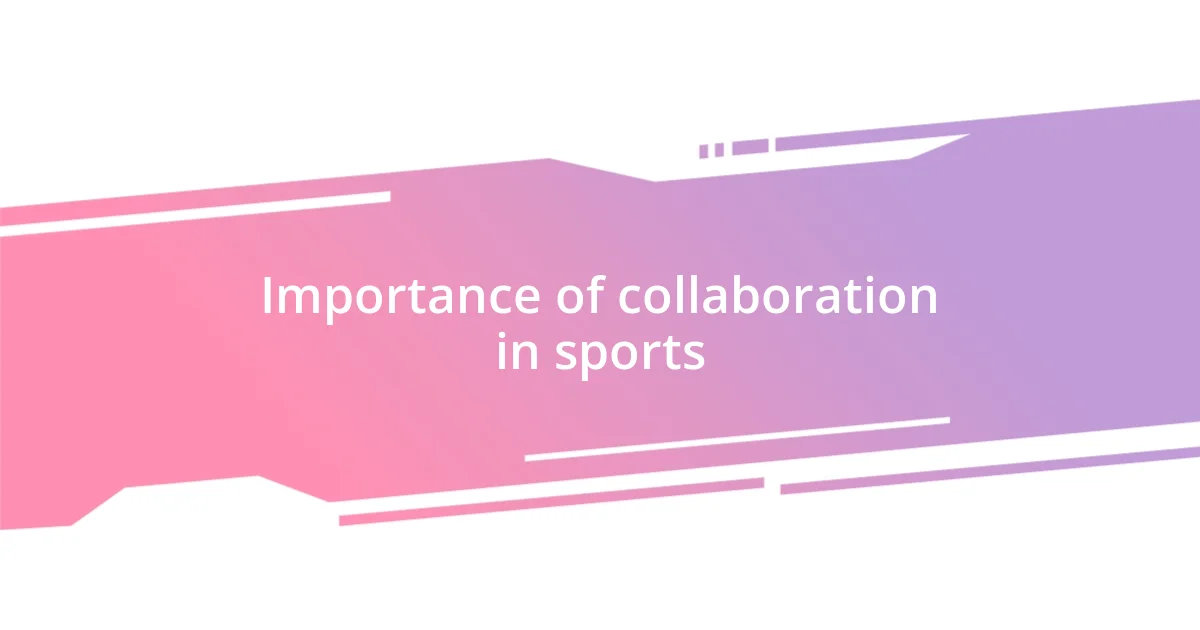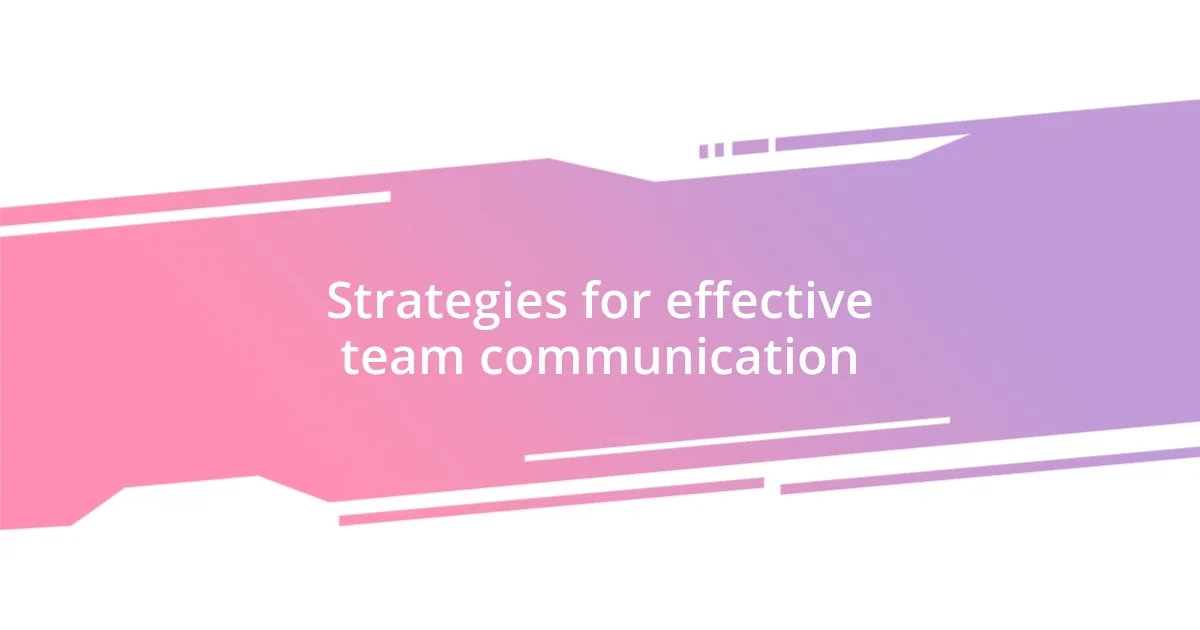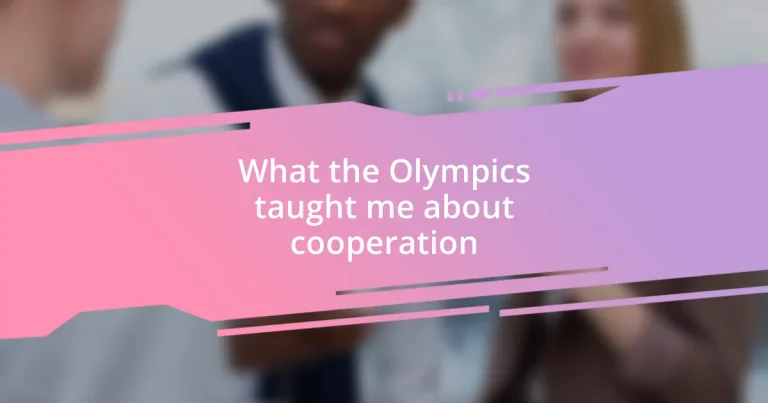Key takeaways:
- Collaboration in sports and team settings enhances performance, communication, and morale, demonstrating that shared success is vital.
- Effective communication strategies, including active listening and clear expectations, foster unity and prevent misunderstandings within teams.
- Addressing conflicts through open dialogue and creating a safe space for expression builds trust and enhances team dynamics, encouraging cooperation beyond sports.

Lessons from Olympic teamwork
When I think about Olympic teamwork, I’m reminded of how athletes often set aside personal glory to lift one another up. For instance, during the relay races, each runner relies on the others to succeed. It’s like a dance—one misstep can lead to a fall, but when they all sync perfectly, the result is something extraordinary. Isn’t that a powerful reminder of how in our own lives, collaboration can lead to successes we couldn’t achieve alone?
Watching teams like the U.S. women’s gymnastics squad really hits home. Their communication and trust seem seamless, yet I imagine the hours spent working through differences and building that rapport. That shared resilience is palpable; it reminds me of times in my own life when a supportive team helped me push through challenges. Have you ever felt that bond in a group? It’s truly unparalleled.
There’s something beautifully humbling about the way Olympic athletes celebrate each other’s achievements, regardless of scoring or medals. It makes you wonder—what if we adopted that spirit in our daily lives? Embracing others’ successes could transform our workplaces and friendships. From my perspective, learning to cheer for others, even when it’s not about you, can create a stronger community.

Importance of collaboration in sports
Collaboration in sports is like the backbone of any successful team. I’ve seen firsthand how essential it is for athletes to gel, especially during tense moments. I recall a local soccer match where, after a series of losses, my teammates and I sat down to openly discuss our weaknesses. That conversation transformed our approach; we learned to communicate better, support each other on the field, and ultimately clinched a much-needed win. It’s funny how a simple chat can lead to such powerful results.
- Each player’s strengths amplify the team’s overall performance.
- Trust among teammates fosters open communication, reducing errors.
- Effective collaboration cultivates a supportive environment, enhancing mental well-being.
- Celebrating collective, not just individual, victories boosts morale and inspires everyone involved.
Seeing this level of teamwork in the Olympics makes it clear that cooperation isn’t just an asset; it’s a necessity for achieving greatness. Whenever I see teams function smoothly, I can’t help but think back to those moments on the field where we discovered the magic that happens when people unite for a common goal. It’s an exhilarating feeling that sticks with you long after the game is over.

Strategies for effective team communication
Effective team communication is often the lifeblood of success in any collaborative effort. In my experience, active listening has played a crucial role—it’s amazing how simply listening can foster an atmosphere where everyone feels valued. During a recent project, my team and I hit a roadblock. Instead of pushing through individually, we gathered for a brainstorming session. Each voice mattered, and we emerged not only with solutions but also with a renewed sense of unity. Have you ever felt how listening changes the dynamics of a conversation?
Setting clear expectations is another strategy that’s proven invaluable. I remember a time during a group presentation where I was assigned a particular section but felt unsure about the overall direction. By outlining everyone’s roles and responsibilities at the start, we were able to align our visions. This upfront clarity prevented confusion later and resulted in a presentation that flowed seamlessly. It reinforced my belief that when communication is clear from the get-go, it keeps the team focused and reduces misunderstandings.
Lastly, embracing feedback can significantly enhance team dynamics. I once participated in a community project where we adopted a feedback loop approach. Every week, we shared constructive critiques, which not only improved our work but also built trust among team members. It created an environment where everyone felt comfortable expressing ideas. Isn’t it incredible how feedback can be the catalyst that transforms a good team into a great one?
| Strategy | Description |
|---|---|
| Active Listening | Fostering an environment where everyone feels valued through attentive listening. |
| Clear Expectations | Defining roles and responsibilities to avoid confusion and align team efforts. |
| Embracing Feedback | Creating an open culture for sharing constructive critiques to enhance trust and collaboration. |

Overcoming conflicts in team settings
Navigating conflicts in a team can feel like walking a tightrope; one misstep can lead to a stumble. I’ve been in situations where disagreements arose during team activities, such as once when I clashed with a teammate over strategy. Instead of letting the tension simmer, I initiated a one-on-one discussion to voice our perspectives. It turned out that our differing ideas weren’t just obstacles, but valuable insights that helped sharpen our approach. Isn’t it fascinating how addressing conflict head-on can lead to growth instead of division?
Understanding diverse perspectives is crucial in resolving team conflicts. I remember taking part in a volunteer group where opinions about our project’s direction varied widely. Instead of allowing frustration to build, we set aside time to hear each other out. This openness didn’t just ease the tension; it cultivated camaraderie. By appreciating our differences, we found creative solutions that none of us had considered alone. Doesn’t it make you wonder how much more effective teams could be if they embraced rather than resisted differing viewpoints?
Creating a safe space for expression is another key element in overcoming conflicts. During a sports season, our coach encouraged us to voice our concerns during team meetings. I was surprised at how sharing my feelings about a missed goal led to honest conversations about pressure we all felt. That practice not only mended rifts but also transformed our team into a unit that thrived on mutual support. When have you felt the power of vulnerability in your own team experiences? It’s a wonderful reminder that when team members feel secure, they can tackle conflicts rather than being hindered by them.

Building trust among team members
Building trust among team members is essential for creating a collaborative environment. My experience on a volunteer sports team taught me that trust develops when teammates can rely on one another. After a shaky start with a new teammate, we agreed to share our individual strengths and weaknesses openly. This transparency opened doors to honest discussions, and it made it easier for us to depend on each other during critical moments. Don’t you think that when you know someone’s genuine self, it’s easier to trust them?
As we bonded, I discovered how vital support and encouragement were to building that trust. There was a time during practice when I struggled to execute a complex move. Instead of judgment, my teammates provided uplifting feedback, which motivated me to keep trying. I felt a sense of belonging, and it encouraged me to support others in return. Doesn’t it feel amazing when a little encouragement can shift the team dynamic and create unshakeable bonds?
Being accountable to each other has also played a significant role in establishing trust in my teams. I have been part of groups where we set up a buddy system, checking in on one another’s progress toward our goals. I remember one instance where my accountability partner noticed I was lagging behind. She reached out to me instead of letting it slide, and the conversation we had not only got me back on track but also deepened our trust. Isn’t it interesting how sharing responsibility can knit a team closer together?

Inspiring cooperation outside of sports

Cooperation doesn’t just shine in sports; it extends into community initiatives as well. I once joined a neighborhood clean-up project, and it struck me how diverse volunteers came together for a common cause. We each brought unique skills, from organizing to landscaping, and this collective effort transformed not just our environment, but our sense of community. Have you ever seen how powerful it is when people from different backgrounds unite for a shared goal?
Sometimes, the magic happens in unexpected places. I recall a time during my college years when we organized a fundraising event for a local charity. The planning process was chaotic; we had a mix of ideas and approaches. However, rather than letting our differences lead to frustration, we embraced our varied perspectives. Those spirited discussions led to innovative fundraising strategies beyond what any of us could have conceived alone. Isn’t it wonderful how collaboration can spark creativity?
Moreover, I’ve learned that celebrating small successes can foster ongoing cooperation. In one community garden project, we made it a point to acknowledge each step we accomplished, from planting to harvesting. This positivity built momentum and strengthened our bond as neighbors. Every small win felt significant and encouraged ongoing collaboration. Can you imagine how a simple acknowledgment can create a ripple effect of motivation in team settings?














